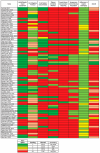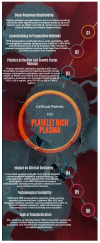Systematic Review of Platelet-Rich Plasma in Medical and Surgical Specialties: Quality, Evaluation, Evidence, and Enforcement
- PMID: 39124838
- PMCID: PMC11313071
- DOI: 10.3390/jcm13154571
Systematic Review of Platelet-Rich Plasma in Medical and Surgical Specialties: Quality, Evaluation, Evidence, and Enforcement
Abstract
Background: Platelet-rich plasma (PRP) is widely used in various medical and surgical specialties for its regenerative properties, including aesthetics (facial rejuvenation, hair restoration, and skin tightening) and orthopedics (treatment of tendinitis and osteoarthritis). However, the inconsistent literature on PRP's efficacy and safety leads to critical knowledge gaps. This systematic review evaluates quality control measures in PRP preparation and application and explores the regulatory environment governing its clinical use. Methods: Following PRISMA guidelines, a comprehensive search was conducted across multiple databases, including PubMed, EMBASE, and Web of Science, for studies published from January 2020 to April 2024. The review included randomized controlled trials (RCTs) involving human participants undergoing PRP treatment for aesthetic or regenerative purposes. Key parameters such as the PRP preparation methods, platelet concentration, and quality control measures were analyzed. The study protocol was registered with PROSPERO (ID: CRD42024557669). Results: Out of 75 RCTs involving 5726 patients, the review identified significant variability in PRP preparation methods and application techniques, including differences in centrifugation protocols and platelet concentration levels. A new evidence-based scoring system, the William-Eqram Scoring System for PRP Quality Reporting (WESS-PQR), was proposed to address these inconsistencies. Correlation analysis revealed a strong positive correlation (r = 0.79) between proper temperature control during preparation and PRP efficacy. Initial platelet count assessment showed a moderate positive correlation (r = 0.57) with efficacy. Conclusions: Standardized PRP preparation protocols and robust regulatory frameworks are urgently needed to ensure the safety and efficacy of PRP treatments. The proposed WESS-PQR scoring system can serve as a valuable tool for clinicians and researchers, promoting consistency and reliability in PRP applications.
Keywords: PRP; WESS-PQR; efficacy; platelet-rich plasma; quality control; regenerative medicine; regulatory standards.
Conflict of interest statement
The authors declare no conflicts of interest.
Figures






References
Publication types
LinkOut - more resources
Full Text Sources
Research Materials
Miscellaneous

